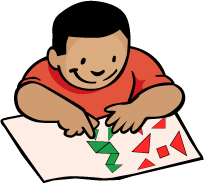Boston Children's Museum
308 Congress Street, Boston, MA 02210
617-426-6500
© Boston Children’s Museum 2025
Website Design by JackrabbitTangrams have existed for hundreds, maybe even thousands of years. They have remained popular for so long because they are simple to engage in, yet they can truly challenge the mind. By experimenting with tangrams, children will learn about a game from another culture while they investigate geometric concepts, properties and relationships. Tangrams also help children to develop visual thinking, spacial sense and problem solving skills.
Make your own tangram set using the instruction son the Making a Tangram Set page (click here for PDF), and Tangram Template (click here for PDF). Making the set is a good opportunity for you students to see how these pieces can fit together to make a square.
If you would prefer to make it a little easier for your students, or if you are working with younger children, you can photocopy the Tangram Template, also found after these activity sheets. You can either have students cut the pieces out along the lines, or you can cut sets ahead of time for the whole class.

Ask your students if they have ever played with a puzzle before (the kind with pieces that fit together). Is there more than 1 or only 1 way to solve this kind of puzzle? Tell your students that they are going to play with a kind of puzzle with pieces that fit together in lots of different ways. This puzzle game is called “tangrams” and comes from China. If you have a world map, have them find China on it.
Make your own tangram set and see if you can solve the tangram puzzles—or make your own tangram shapes!
Once each team has played with this challenge for a few minutes, bring the whole group together to talk about what they discovered. Was it easy or hard to fit the pieces together into a square? If they created their own set of pieces, did it help that they saw the pieces together as a square earlier? Can they think of any other shapes they might be able to make? It is very possible that some of your students have played with tangrams before. Ask if any of them have, and what shapes they have created with tangrams.
Make copies of the Tangrams Puzzles sheet (Click for PDF), or draw some shapes that you select from that sheet on a piece of chart paper or a chalkboard. Challenge the teams to come up with a solution—remember, they must use all 7 pieces of their tangram set to create the shapes in each puzzle! Solutions for the puzzles can be found here (Click for PDF). As your students are solving these puzzles, ask them questions about their process, like “How many different ways can you fill in one puzzle?,” “What do you do when you can’t figure out a puzzle?,” “How are shapes similar?,” “Can you substitute some shapes for others?,” etc. At the end of the session, have students share their solutions with each other.